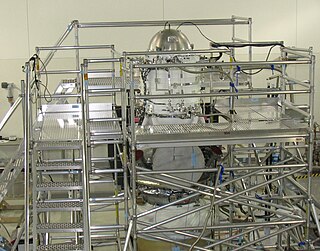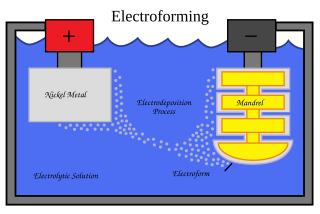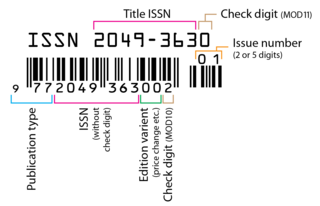
Infrared astronomy is the branch of astronomy and astrophysics that studies astronomical objects visible in infrared (IR) radiation. The wavelength of infrared light ranges from 0.75 to 300 micrometers. Infrared falls in between visible radiation, which ranges from 380 to 750 nanometers, and submillimeter waves.
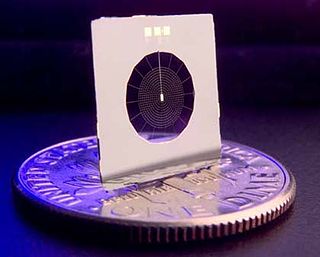
A bolometer is a device for measuring the power of incident electromagnetic radiation via the heating of a material with a temperature-dependent electrical resistance. It was invented in 1878 by the American astronomer Samuel Pierpont Langley.

Forward-looking infrared (FLIR) cameras, typically used on military and civilian aircraft, use a thermographic camera that senses infrared radiation.

Night vision is the ability to see in low-light conditions. Whether by biological or technological means, night vision is made possible by a combination of two approaches: sufficient spectral range, and sufficient intensity range. Humans have poor night vision compared to many animals, in part because the human eye lacks a tapetum lucidum.

A thermographic camera is a device that forms a heat zone image using infrared radiation, similar to a common camera that forms an image using visible light. Instead of the 400–700 nanometre range of the visible light camera, infrared cameras operate in wavelengths as long as 14,000 nm (14 µm). Their use is called thermography.

Infrared thermography (IRT), thermal imaging, and thermal video are examples of infrared imaging science. Thermographic cameras usually detect radiation in the long-infrared range of the electromagnetic spectrum and produce images of that radiation, called thermograms. Since infrared radiation is emitted by all objects with a temperature above absolute zero according to the black body radiation law, thermography makes it possible to see one's environment with or without visible illumination. The amount of radiation emitted by an object increases with temperature; therefore, thermography allows one to see variations in temperature. When viewed through a thermal imaging camera, warm objects stand out well against cooler backgrounds; humans and other warm-blooded animals become easily visible against the environment, day or night. As a result, thermography is particularly useful to the military and other users of surveillance cameras.
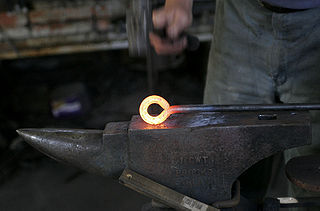
The emissivity of the surface of a material is its effectiveness in emitting energy as thermal radiation. Thermal radiation is electromagnetic radiation and it may include both visible radiation (light) and infrared radiation, which is not visible to human eyes. The thermal radiation from very hot objects is easily visible to the eye. Quantitatively, emissivity is the ratio of the thermal radiation from a surface to the radiation from an ideal black surface at the same temperature as given by the Stefan–Boltzmann law. The ratio varies from 0 to 1. The surface of a perfect black body emits thermal radiation at the rate of approximately 448 watts per square metre at room temperature ; all real objects have emissivities less than 1.0, and emit radiation at correspondingly lower rates.

Many ceramic materials, both glassy and crystalline, have found use as optically transparent materials in various forms from bulk solid-state components to high surface area forms such as thin films, coatings, and fibers. Such devices have found widespread use for various applications in the electro-optical field including: optical fibers for guided lightwave transmission, optical switches, laser amplifiers and lenses, hosts for solid-state lasers and optical window materials for gas lasers, and infrared (IR) heat seeking devices for missile guidance systems and IR night vision.
A microbolometer is a specific type of bolometer used as a detector in a thermal camera. Infrared radiation with wavelengths between 7.5–14 μm strikes the detector material, heating it, and thus changing its electrical resistance. This resistance change is measured and processed into temperatures which can be used to create an image. Unlike other types of infrared detecting equipment, microbolometers do not require cooling.

A passive infrared sensor is an electronic sensor that measures infrared (IR) light radiating from objects in its field of view. They are most often used in PIR-based motion detectors. PIR sensors are commonly used in security alarms and automatic lighting applications. PIR sensors detect general movement, but do not give information on who or what moved. For that purpose, an active IR sensor is required.
A staring array, staring-plane array, focal-plane array (FPA), or focal-plane is an image sensing device consisting of an array of light-sensing pixels at the focal plane of a lens. FPAs are used most commonly for imaging purposes, but can also be used for non-imaging purposes such as spectrometry, LIDAR, and wave-front sensing.

An infrared thermometer is a thermometer which infers temperature from a portion of the thermal radiation sometimes called black-body radiation emitted by the object being measured. They are sometimes called laser thermometers as a laser is used to help aim the thermometer, or non-contact thermometers or temperature guns, to describe the device's ability to measure temperature from a distance. By knowing the amount of infrared energy emitted by the object and its emissivity, the object's temperature can often be determined within a certain range of its actual temperature. Infrared thermometers are a subset of devices known as "thermal radiation thermometers".
Lead selenide (PbSe), or lead(II) selenide, a selenide of lead, is a semiconductor material. It forms cubic crystals of the NaCl structure; it has a direct bandgap of 0.27 eV at room temperature. It is a grey crystalline solid material.

An infrared countermeasure (IRCM) is a device designed to protect aircraft from infrared homing missiles by confusing the missiles' infrared guidance system so that they miss their target. Heat-seeking missiles were responsible for about 80% of air losses in Operation Desert Storm. The most common method of infrared countermeasure is deploying flares, as the heat produced by the flares creates hundreds of targets for the missile.
A flame detector is a sensor designed to detect and respond to the presence of a flame or fire, allowing flame detection. Responses to a detected flame depend on the installation, but can include sounding an alarm, deactivating a fuel line, and activating a fire suppression system. When used in applications such as industrial furnaces, their role is to provide confirmation that the furnace is working properly; in these cases they take no direct action beyond notifying the operator or control system. A flame detector can often respond faster and more accurately than a smoke or heat detector due to the mechanisms it uses to detect the flame.
Infrared vision is the capability of biological or artificial systems to detect infrared radiation. The terms thermal vision and thermal imaging, are also commonly used in this context since infrared emissions from a body are directly related to their temperature: hotter objects emit more energy in the infrared spectrum than colder ones.

A transition-edge sensor (TES) is a type of cryogenic energy sensor or cryogenic particle detector that exploits the strongly temperature-dependent resistance of the superconducting phase transition.
Active thermography is an advanced nondestructive testing procedure, which uses a thermography measurement of a tested material thermal response after its external excitation. This principle can be used also for non-contact infrared non-destructive testing (IRNDT) of materials. The IRNDT method is based on an excitation of a tested material by an external source, which brings some energy to the material. Halogen lamps, flash-lamps, ultrasonic horn or other sources can be used as the excitation source for the IRNDT. The excitation causes a tested material thermal response, which is measured by an infrared camera. It is possible to obtain information about the tested material surface and sub-surface defects or material inhomogeneities by using a suitable combination of excitation source, excitation procedure, infrared camera and evaluation method.


